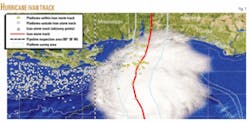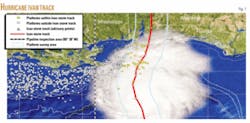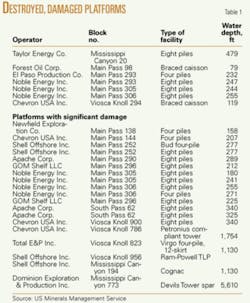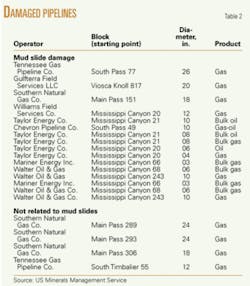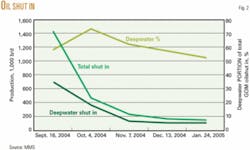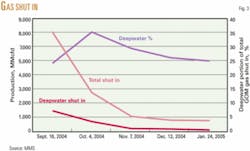Hurricane Ivan shut down much production in the eastern portion of the Gulf of Mexico and damaged pipelines and platforms in its path and along the Mississippi River delta apron. But as a credit to the industry’s preparedness, the storm caused no loss of life nor major pollution.
The US Minerals Management Service (MMS) estimated that 150 platforms and 10,000 miles of pipeline were in the direct path of Hurricane Ivan (Fig. 1). The gulf has about 4,000 structures and 33,000 miles of pipelines.
The storm destroyed seven platforms in shallow water and caused damage to 102 pipelines, according to MMS. The agency also said 24 platforms had significant damage. Tables 1 and 2 list some platforms and pipelines that felt the storm’s impact.
As of Feb. 14, 2004, MMS estimated Hurricane Ivan had caused operators to shut in a cumulative 43.8 million bbl of oil and 172 bcf of gas, the most in the gulf’s history (Figs. 2 and 3).
The shut-in oil is about 7.246% of the yearly gulf production of about 605 million bbl, while the shut-in gas is about 3.871% of the yearly gulf production of about 4.45 tcf.
Although the storm shut in much production for an unprecedented time, the number of platforms destroyed or damaged was less than during Hurricane Andrew in 1992.1
Hurricane Ivan
The storm entered the gulf on Sept. 13, 2004, and forecasts projected it to make landfall on the southern gulf coast on Sept. 16, 2004, with sustained winds up to 130 mph.
MMS said that the industry evacuated, without injury to personnel, 69 rigs, about 60% of the rigs drilling in the gulf, and 575 manned platforms, about 75% of the gulf’s manned platforms. It estimated that by the afternoon of Sept. 16, the industry had shut in more than 70% of the gulf’s oil production and about 60% of its gas production.
MMS estimated the storm produced a 52-ft significant wave height (equivalent to a theoretical 90-ft maximum wave height), the highest ever reported in the Gulf of Mexico, according to National Oceanic and Atmospheric Administration (NOAA) records. MMS further added that waves higher than 52 ft were likely although not measured with damage to some platforms suggesting wave crests of at least 60-65 ft (equivalent to a wave height of at least 90 ft) above sea level.
The high wave heights generated by the storm caused much of the damage. T. Laurendine of the MMS, at the recent Offshore Technology Conference in Houston, said of the seven platforms now lying on the sea floor, waves destroyed six and a mudslide destroyed one.
He said the industry had completed all inspections by May 1, 2005, and expected all repairs to have been made by June 1.
Laurendine said the main concerns regarding gulf operations that Hurricane Ivan generated include:
- Anchoring drilling rigs on floating production platforms. If operators had secured the drilling rigs better on some floating platforms affected by Hurricane Ivan, these installations would not have suffered as much damage.
- Pipeline failures.
- Mobile rigs breaking off mooring and running adrift.
Failures along the submerged delta apron of the Mississippi River caused much of the damage to pipelines. Studies indicate that intense storms such as Hurricane Ivan can create region-wide sea floor failures and mud flows.2
BP America Inc. and Shell Pipeline Co. LP were two of the companies that found damaged pipelines in the eastern part of the gulf.
In an OTC presentation, J. Thomsaon of BP said sonar data showed BP’s Main Pass Oil Gathering (MPOG) system to be displaced in three places.3 He attributed the largest displacement in the Main Pass 144 area of more than 1,900 ft over a 27.5-mile length to strong, turbid bottom currents acting on uncoated pipe. In Main Pass 73, he attributed the displacement to mudslide activity in the delta front.
M.J. Coyne of Shell Oil Products US Co. said, during another OTC presentation, that Shell found that Hurricane Ivan had completely disabled its crude oil system that transports crude from Na Kika, Petronius, Ram-Powell, Main Pass 289, and Main Pass 252, and Horn Mountain.3 He added that Ivan also hit pump stations and delivery terminals tied to the pipeline system that carried about 400,000 bo/d.
It took Shell more than a month to bring the system back on line. Coyne said Shell returned to service the 18-in. Na Kika oil pipeline and Delta system below Main Pass 69 downstream of the Main Pass 69 P pump station on Oct. 24, 2004. Its Odyssey 20-in. system went back on line on Oct. 30, 2004, and as of Nov. 15, 2004, all crude oil flow capabilities of Shell Pipeline Co. LP (SPLC) became available, according to Coyne.
At OTC, G.E. Sgouros of Shell E&P Co. explained that the three Shell operated facilities that sustained major damage were: Ram-Powell (Viosca Knoll 956A), Bud (Main Pass 252), and Cognac (Mississippi Canyon 194A).3
He said all the structures were sound but had damaged topsides. In the case of Ram-Powell, the drilling rig had moved more than 60 ft, causing damage to varied equipment. Sgouros said Shell restored partial production on Cognac on Oct. 13, 2004, MP 252 during January 2005, and on Ram-Powell in March 2005.
D. Wisch of ChevronTexaco Energy Technology Co., in his presentation at OTC, said that some Chevron platforms on the shelf were subjected to wave conditions approaching or exceeding the 100-year criteria with the Petronius compliant tower encountering waves approaching the local 1,000-year level.1
Wisch said that the limited amount of platform damage caused by the storm in the eastern gulf “indicates that present design practices used today and the conservatisms that exist in API RP-2A design guidelines generally ensure robust structures that can withstand loads 20-30% higher than those used for design.”
Of Chevron platforms, the storm toppled a small, braced-caisson platform, damaged braces on two jacket-type platforms, caused wind damage on one jacket-type platform, and damaged the topsides on the deepwater Petronius compliant tower.1
Chevron restored production of 42,000 bo/d and 65 MMcfd of gas on Petronius in March 2005.
Proposed studies
To study the storm damage and responses further, MMS awarded six contracts worth more than $600,000 to:
- The Texas A&M University Offshore Technology Research Center (OTRC) for assessing storm sea fastenings on floating platforms.
- Offshore Risk & Technology Consulting Inc., for studying station-keeping failures and mooring standards.
- Det Norske Veritas for assessing pipeline damage.
- Energy Engineering Inc. for assessing the performance of fixed platforms during Ivan and other storms.
- OTRC for investigating mud flows and mud slides.
- William Lettis & Associates Inc. for conducting a pilot for regional mapping of mud-slide susceptibility.
MMS said, “These studies will analyze and assess the consequential damage to structures and pipelines, determine the effectiveness of current design standards and pollution-prevention systems, and develop recommendations for changes to industry standards and MMS regulations, if needed.”
MMS also plans to hold a workshop on Hurricane Ivan on July 26-27 in Houston to discuss hurricane preparedness with the industry further.
References
- Hooper, J.R., and Suhayda, J.N., “Hurricane Ivan as a Geologic Force: Mississippi Delta Front Seafloor Failures,” OTC Paper No. 17737, OTC, May 2-5, 2005.
- Thomson, J., “Sonar surveys of pipeline inspection show extent of pipeline displacement and seafloor instability following Hurricane Ivan,” OTC Paper No. 17738, OTC, May 2-5, 2005.
- Coyne, M.J., and Dollar, J.J., “Shell Pipeline’s Response and Repairs after Hurricane Ivan,” OTC Paper No. 17734, OTC, May 2-5, 2005.
- Sgouros, G.E., et al., “Shell’s Experience with Hurricane Ivan,” OTC Paper No. 17733, OTC, May 2-5, 2005.
- Wisch, D., et al., “Experience From Shelf and Deepwater Fixed Platforms During Hurricane Ivan,” OTC Paper No. 17735, OTC, May 2-5, 2005.
